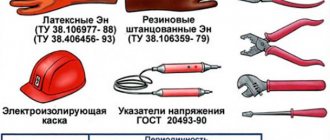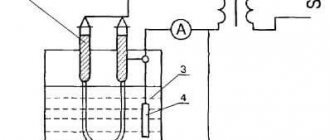When repairing, connecting, or maintaining electrical equipment and networks, even when the voltage is removed, there is a possibility of receiving an electric shock. There is a risk that someone will turn on the switch or press the starter button; you may trip and touch live conductive surfaces. Based on this, current electrical safety rules require the mandatory use of PPE that can prevent electrical injuries or reduce the severity of damage.
Normative base
Order of the Ministry of Labor of Russia dated July 24, 2013 N 328n “On approval of the Rules for labor protection during the operation of electrical installations”
Order of the Ministry of Energy of Russia dated January 13, 2003 N 6 “On approval of the Rules for the technical operation of consumer electrical installations”
Order of the Ministry of Energy of Russia dated June 30, 2003 N 261 “On approval of the Instructions for the use and testing of protective equipment used in electrical installations”
Sad statistics
According to statistics, up to 30,000 people die from electric shock every year. Most often, the causes of electrical injuries are ignorance of the mechanism of physiological effects of electric current on the human body, violation of current rules and instructions on occupational safety and non-use of personal protective equipment.
The consequences of possible injury from direct electric current can be different - from quite mild to very sad, for example:
- convulsive muscle contraction without loss of consciousness;
- convulsive muscle contraction with loss of consciousness, but with preserved breathing and heart function;
- loss of consciousness and disturbances in cardiac activity or breathing (or both);
- clinical death, that is, lack of breathing and blood circulation.
The following components influence the outcome of an electric shock:
- the duration of passage of electric current through the human body;
- frequency and type of current;
- physiological characteristics of a person;
- resistance to stress;
- voltage value.
Every employer must make every effort to eliminate the causes of electrical injuries at the enterprise. First of all, this is facilitated by the training of personnel servicing electrical installations and the use of the necessary PPE. By the way, the employer must provide personal protective equipment to employees completely free of charge when working in electrical installations.
Recommendations for selection
When choosing electrical protection means, the following general recommendations must be taken into account:
- The insulating dielectric handle of the device must have a ring at the end . At the same time, the height of such a ring for devices operating in networks above 1000 V must be at least 5 mm, and for devices operating in networks with lower voltages - 3 mm.
- The insulating part of the device must be made of a dielectric that does not absorb moisture and has stable dielectric and mechanical characteristics.
- The surface of the handles should be smooth and free of cracks and chips.
- The design of the electrical protective device must not allow the possibility of a phase short circuit or a phase-to-ground fault.
Men's overalls are workwear that exists in many enterprises as a mandatory uniform for men.
Where they use working men's denim overalls, read in a separate article. Nitrile rubber gloves are resistant to high temperatures. Find out where nitrile gloves are widely used in this publication.
What you need to know
Of course, the best protection against electric shock is a “head on your shoulders.” To protect yourself from electrical injuries, you need to know:
- “Rules on labor protection during the operation of electrical installations”, approved. By Order of the Ministry of Labor of the Russian Federation dated July 24, 2013 No. 328n (as amended on February 19, 2016);
- "PTEEP", approved. By Order of the Ministry of Energy of the Russian Federation dated January 13, 2003 No. 6;
- “Rules for electrical installations”, approved. Order of the Ministry of Energy of the Russian Federation dated May 20, 2003 No. 187 (as amended on December 20, 2017) and other regulations relating to this area.
Next, we will talk in detail about the personal protective equipment that every electrician should use in their work.
Information
The definition of “Personal Electrical Protective Equipment” does not mean the personalization of gloves or galoshes. They are used by all personnel in turn during work. The period of use of the funds by each employee is also not limited by anyone; only the frequency of testing is established.
Since protective equipment ensures safety (including the lives of personnel), tests are carried out within the prescribed time frame. Regardless of the voltage of use, certain deadlines are established for each item:
- Gloves are inspected every 6 months; there are no inspection standards for mats and stands.
- Tools and voltage indicators - once a year.
- Galoshes are checked every year, boots every three years.
- Isolating clamps are tested every 2 years.
Tests are carried out in specialized laboratories. As a rule, the procedure involves immersing an insulated object in a container of water and testing for breakdown at the maximum permissible voltage. If the insulation allows voltage breakdown, the product is rejected. The use of such devices is prohibited.
Restoring protective devices is also not permitted. Defective products are disposed of or used for work without voltage supply.
The frequency of inspection of fixed assets is not established; this is done before work is carried out. The integrity, cleanliness and dryness of safety equipment is checked.
What types of personal protective equipment are there (electrical safety)
PPE intended to protect a person from the effects of current is usually made partially or completely from materials that do not conduct it (rubber, porcelain, wood with special impregnation). There are collective and individual means of protection in electrical installations.
Collective ones include:
- safety barriers;
- grounding, grounding and disconnection of electrical equipment housings that may be energized;
- use of safe voltage 12-36 V;
- warning posters (they are usually hung near dangerous places);
- automatic air circuit breakers.
Personal protective equipment against electric current is divided into basic and additional.
Basic - these personal protective equipment in electrical installations withstand direct contact with live objects for a long time. Therefore, they are used when carrying out electrical installation work without de-energizing electrical devices from the network.
Also, depending on the voltage in the network, there are two types of conditions in which electrician personal protective equipment is used: up to 1000 V and over 1000 V. The same classification applies to additional equipment.
Basic personal protective equipment for electricians up to 1000 V:
- dielectric gloves;
- insulating rods;
- insulating and electrical clamps;
- plumbing and assembly tools with insulating handles;
- voltage indicators.
In electrical installations over 1000 V:
- insulating rods;
- insulating and electrical clamps;
- voltage indicators;
- means for repair work under voltage above 1000 V.
Additional - this protection is not able to fully protect a person from the effects of electric current, and therefore such PPE is used in conjunction with the main ones. Let us consider this type of funds in more detail and list what applies to them.
In electrical installations up to 1000 V:
- dielectric galoshes;
- dielectric carpets;
- insulating stands.
In electrical installations over 1000 V:
- dielectric gloves;
- dielectric boots;
- dielectric carpets;
- insulating stands;
- dielectric gaskets and caps.
We will give a list of personal protective equipment for electricians, most often used in electrical installation work.
Dielectric gloves
Protect human hands from touching devices and parts that are under electrical voltage. Most often they are made from sheet rubber and have a universal size. Gloves marked “Ev” are additional PPE when working with electrical voltages over 1000 Volts.
And the “En” marking means that the gloves are capable of protecting a worker from exposure to electric current of up to 1000 Volts. In this case, this type of PPE is the main one.
Only dry gloves that have passed a leak test are allowed for use.
Insulating pliers
Insulating pliers are PPE when working in electrical installations up to and above 1000 V, as well as for:
- installation and removal of fuses;
- removing insulating linings;
- removal of fence panels and other similar work in electrical installations up to 35 kV inclusive.
They consist of a working part (plier jaws), an insulating part and a handle. When working with them, you should additionally use dielectric gloves and PPE to protect your eyes and face.
Voltage indicators
Before starting installation or repair work on power plants and wires, it is necessary to monitor the network indicators, check the absence of current or its parameters. For this purpose, a voltage indicator is used, which can determine the presence of voltage and its coincidence up to 1000 V.
The most commonly used devices are voltages up to 1000 Volts. Such an indicator can be double-pole or single-pole. Bipolar ones are more accurate, which is why they are called high-voltage and are used during complex work.
Dielectric mats
Such dielectric personal protective equipment is a mat under the feet that does not conduct electric current. Mats are placed in front of electrical panels and high voltage cabinets.
Most often they are made of rubber with a special layer. Additionally, a corrugated pattern with a depth of 3-5 millimeters is made on the surface of the litter, which reduces the contact area and increases the resistance to current flow along the surface of the product. The maximum voltage withstandable by the dielectric mat is indicated by the manufacturer on the label.
Dielectric stairs
When carrying out repair work, it often becomes necessary to perform actions at a certain height. The use of a conventional metal ladder (for example, aluminum) creates a high risk of electric shock to the worker. Therefore, in such cases, you should use special dielectric ladders. They are made of lightweight but durable fiberglass and are therefore safe.
Purpose and characteristics
When workers operate in electrical installations, there is always the possibility that even the most advanced protective equipment used will not be able to ensure their safety . For example, when people are near live parts, there is a possibility of accidentally touching them.
To prevent the negative impact of this phenomenon on the body, special isolation is required for the worker and the tool. Another example is the accidental supply of power to disconnected networks that are being repaired.
To prevent possible electric shock to repair workers in this case, it is also necessary to use some methods to prevent an accident.
The number of such funds is quite large. Moreover, their different types have their own set of characteristics , which differ from each other. For example, for items such as gloves, overshoes or boots, the operating temperature range, material from which they are made, size, and testing requirements are given.
For more complex devices, for example, electrical clamp meters, which are a transformer with a digital indication of the amount of current flowing, the characteristics of the device include a large number of parameters. Along with the conditions, operation and dimensions of the device, the ranges of measured network parameters are given.
A protective equipment (PP) is considered a device that can be used to prevent the effects of hazardous production factors on a person.
Checking personal protective equipment in electrical installations
All protective equipment put into service must be checked periodically. After all, a person’s life depends on their condition. According to Appendix 7 “Instructions for the use and testing of protective equipment used in electrical installations”, approved. Order of the Ministry of Energy dated June 30, 2003 No. 261 established the following frequency of inspection of electrical protective personal protective equipment (number of checks, time period).
Inspected products are stamped with dates for use. If the test results fail the test, the stamp is crossed out with paint. The results of checks are entered into journals.
Storing personal protective equipment in electrical installations is possible only if it is reliably protected from damage, dirt and moisture. They are not stored with tools. Also, personal protective equipment should not be exposed to various chemicals. When transporting, PPE must be kept in covers, boxes or bags. The issuance of protective equipment must be recorded in the employee’s personal PPE issuance card.
Sample personal card
General storage rules
Protective equipment must be stored in conditions that preserve its serviceability and ability to be used. These conditions are:
- protection from mechanical damage, moisture and dirt;
- storage in closed premises;
- storage in specially equipped places.
Large devices such as rods or pliers should be stored on special boards with hooks, and small-sized devices should be stored on racks or in cabinets.
Work on electrical installations has a potential danger for personnel associated with electric shock.
To protect personnel, it is necessary to use electrical protective equipment, which can be collective and individual, basic and additional.
When choosing electrical protection means, it is necessary to check their appearance and compliance of their quality with state standards.










